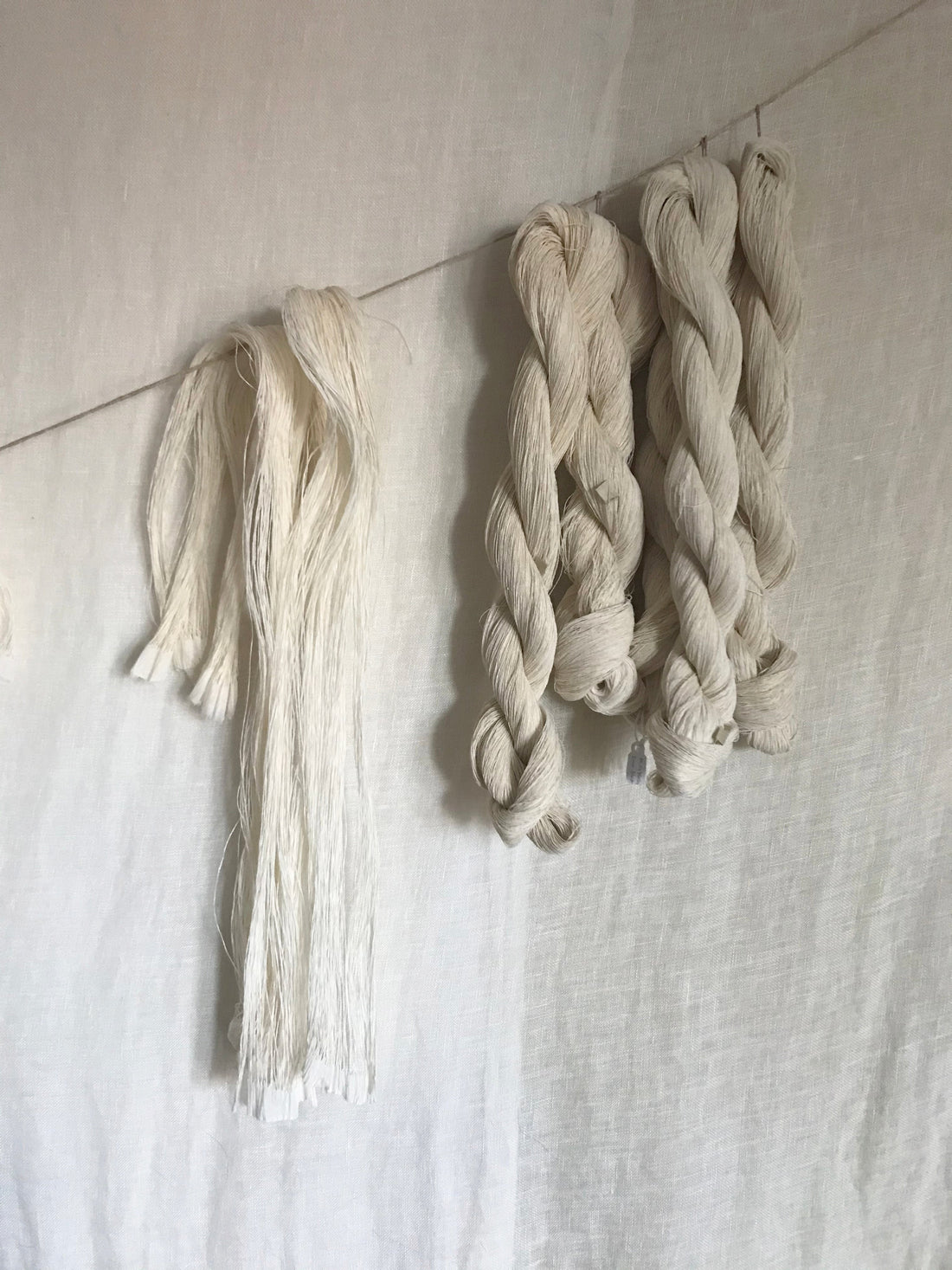
Introducing Sabrina Sachiko Niebler
Sabrina Sachiko Niebler is a shifu weaver, paper thread maker, and natural dyer. She loves working with the tactile nature of fibre. Her particular area of interest is in the quiet and precise beauty of making kami-ito (paper thread) and fine shifu (paper cloth).

During her undergrad at the Alberta University of the Arts, Sachi started weaving with printed paper as a way to imbed text, literally, into cloth. After having woven a portrait of her Obaachan, Sachi fell in love with weaving paper and it never stopped being a source of material pleasure and intrigue. It wasn’t until years later that she discovered the time honoured Japanese practice of creating paper thread and weaving it into cloth. This connected her to a part of her heritage in an unexpected way, and sparked a desire for deeper understanding. Since then, Sachi has been steadily practicing this method of creating with the help of many generous hands and minds. She deeply enjoys the slow process which has somehow always felt innate to her hands and material sensitivity.
Can you tell us a little bit about your practice?
I work with a time-honoured Japanese process of turning washi (Japanese paper) into kami-ito (paper thread) and then weaving it into shifu (woven paper cloth). This involves folding, cutting, rolling, separating, and twisting the washi into thread, boiling or dyeing it, and finally weaving it into fabric. It is a slow and beautiful process which involves dedication, sensitivity and a deep appreciation for handwork.

Not only is the process engaging for the senses, it also creates space for embodied wholeness. For me, the practice of making Shifu has always been a place of care - where presence and energy are given to create the work, while simultaneously flowing back to me as the maker. The craft creates me, as much as I create it. As such, I love thinking about the potential for this caring energy to be embedded into the very fibre of the cloth, as each thread is formed by me inch by inch and then woven into place.
Where did you learn your craft?
I started weaving with paper in my undergrad at the Alberta University of the Arts. I was weaving a tapestry of my obaachan and I wanted a way of including written stories about her, literally imbedded into the cloth; so I thought I would use paper to do that. I wrote on the paper, twisted it into a thick yarn and then wove it into the background of the tapestry. After that, I fell in love with weaving with paper and kept working with it. It wasn’t until about 5 years later that I discovered there is an actual historical Japanese practice of turning paper into thread and cloth. It was an extraordinary moment of discovery because it connected this very natural inclination towards this craft to a deeply rooted Japanese practice of it. In this way, it connected me to a part of my heritage.
Want to read more of this article?
We are proud to be a subscriber-funded publication with members in 185 countries. We know our readership is passionate about textiles, so we invite you to help us preserve and promote the stories, memories, and histories that fabric holds. Your support allows us to publish our magazine, and also ‘what's on’ information, and subscription interviews, reviews, and long-read articles in our online blog.
ALREADY A SUBSCRIBER? CLICK HERE TO ACCESS CONTENT
OR...to continue reading….

*Magazine subscribers automatically get free access to all our online content. We send the access code by email with the publication of each issue. You will also find it on the envelope containing your magazine. Please note the access code changes every issue.*

During her undergrad at the Alberta University of the Arts, Sachi started weaving with printed paper as a way to imbed text, literally, into cloth. After having woven a portrait of her Obaachan, Sachi fell in love with weaving paper and it never stopped being a source of material pleasure and intrigue. It wasn’t until years later that she discovered the time honoured Japanese practice of creating paper thread and weaving it into cloth. This connected her to a part of her heritage in an unexpected way, and sparked a desire for deeper understanding. Since then, Sachi has been steadily practicing this method of creating with the help of many generous hands and minds. She deeply enjoys the slow process which has somehow always felt innate to her hands and material sensitivity.
Can you tell us a little bit about your practice?
I work with a time-honoured Japanese process of turning washi (Japanese paper) into kami-ito (paper thread) and then weaving it into shifu (woven paper cloth). This involves folding, cutting, rolling, separating, and twisting the washi into thread, boiling or dyeing it, and finally weaving it into fabric. It is a slow and beautiful process which involves dedication, sensitivity and a deep appreciation for handwork.

Not only is the process engaging for the senses, it also creates space for embodied wholeness. For me, the practice of making Shifu has always been a place of care - where presence and energy are given to create the work, while simultaneously flowing back to me as the maker. The craft creates me, as much as I create it. As such, I love thinking about the potential for this caring energy to be embedded into the very fibre of the cloth, as each thread is formed by me inch by inch and then woven into place.
Where did you learn your craft?
I started weaving with paper in my undergrad at the Alberta University of the Arts. I was weaving a tapestry of my obaachan and I wanted a way of including written stories about her, literally imbedded into the cloth; so I thought I would use paper to do that. I wrote on the paper, twisted it into a thick yarn and then wove it into the background of the tapestry. After that, I fell in love with weaving with paper and kept working with it. It wasn’t until about 5 years later that I discovered there is an actual historical Japanese practice of turning paper into thread and cloth. It was an extraordinary moment of discovery because it connected this very natural inclination towards this craft to a deeply rooted Japanese practice of it. In this way, it connected me to a part of my heritage.
Want to read more of this article?
We are proud to be a subscriber-funded publication with members in 185 countries. We know our readership is passionate about textiles, so we invite you to help us preserve and promote the stories, memories, and histories that fabric holds. Your support allows us to publish our magazine, and also ‘what's on’ information, and subscription interviews, reviews, and long-read articles in our online blog.
ALREADY A SUBSCRIBER? CLICK HERE TO ACCESS CONTENT
OR...to continue reading….

*Magazine subscribers automatically get free access to all our online content. We send the access code by email with the publication of each issue. You will also find it on the envelope containing your magazine. Please note the access code changes every issue.*
